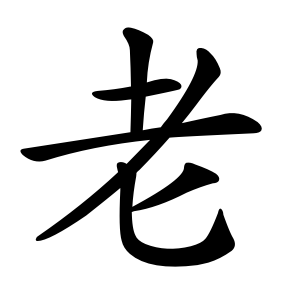老
- old;
It means "to grow old," "to be old," "to become experienced," or "to be familiar with." It represents the concept of aging or long duration.
Etymology
It is a pictograph representing an old person with a bent back holding a cane.
In the Shuowen Jiezi (説文解字 shuōwén jiězì), it is linked with the character 考 (to think) as an example of a phonetic-semantic compound.
When four instances of 老 are combined, they form 𦓋, an ancient form of the character 壽, which means "life" or "longevity."
Usage in Korean
When used as a radical, 老 often appears in the form 耂.
Common characters with the radical 耂 include 考 (to think) and 者 (person, fellow).
Although less frequently used, when the full 老 character itself serves as a radical, the meanings mostly relate to “aging” or “old age,” such as in 耈 (old, aged) and 耋 (old person).
Alternative forms
Words that derived from 老
- 十大心 (JKP)
- ⿱ 耂 匕
